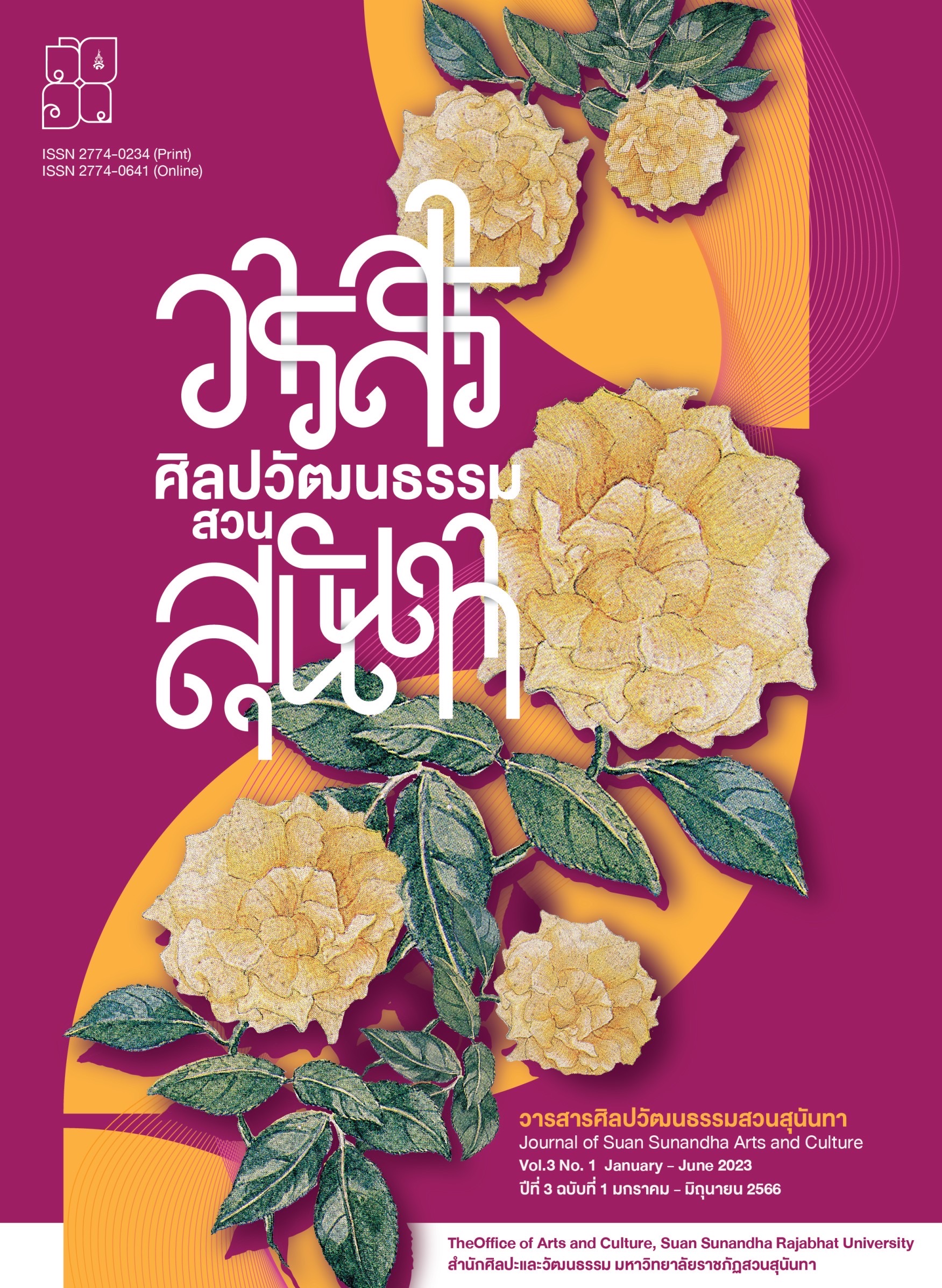BANG BOO CHUANG YIN MUAN TAI: A CREATIVE DANCE INSPIRED BY FOLKWAYS AND BANG BOO PLAY OF THE THAI DUM ETHNICS
Keywords:
Thai Dam ethnic, Bang Boo, Creative DanceAbstract
This creative research was conducted to create a performance from study of history, lifestyle and culture of Tai Dam ethnic group, Ban Na Pa Nat, Khao Kaew Subdistrict, Chiang Khan District, Loei Province, and to disseminate the “bang boo” culture, a tribal musical instrument of the Tai Dam ethnic group. The study used qualitative research method to collect data from academic documents, related research, interviews, and from various information media, to analyze and synthesize until the body of knowledge to the creative design of the performance, called “Bang Boo Chuang Yin Muan Tai”. The results showed that Tai Dam ethnic group Ban Na Pa Nad, Khao Kaeo Subdistrict, Chiang Khan District, Loei Province, migrated from Sipsong Chutai Province during the reign of King Rama V. They have a distinctive identity in terms of costume, dance and music, especially the long-standing bamboo musical instrument known as “Bang Boo”. Has become less popular and is at eminent risk of becoming lost from the record. The research team was inspired by those ideas to represent the identity of “Bang Boo” in form of contemporary Isan dance that still maintains and preserves the identity of the Tai Dam ethnic group. The performance is divided into 3 parts: 1) the way of life of the Tai Dam people, 2) the identity of the Bang Bu musical instrument, and 3) the gathering of the Tai Dam ethnic groups. The dance movement and patterns are a combination of traditional dance postures in the Sae Pang ceremony of the Tai Dam people and using the style of contemporary Isan dance techniques. The costume design retains its original form and is partially modified without affecting the traditional dress codes of the Tai Dam people. The music used in the performance is a newly created from Isan melody. Finally, the props, there are 4 types of Bang Boo namely Bang Boo Toi Pu, Bang Boo Toi Mear, Bang Boo Kaa-taey and Bang Boo Lai. This show can be used for promoting tourism in events as appropriate.
References
นราพงษ์ จรัสศรี. สัมภาษณ์. ศาสตราจารย์ ประจำภาควิชานาฏยศิลป์ คณะศิลปกรรมศาสตร์ จุฬาลงกรณ์มหาวิทยาลัย, 20 ธันวาคม 2562.
พัชร วังทะพันธ์ กิ่งกาญจน์ จันทร์ศิริ และปิยพร โฆสิต. ตุ้มปาง. สืบค้นวันที่ 15 ตุลาคม 2562, จาก https://www.youtube.com/watch?v=Gmdw0LtjW4s, 2561.
เพชรตะบอง ไพศูนย์. หมู่บ้านไทดำ. เลย: เมืองเลยการพิมพ์, 2548.
__________. ไทดำ ความเป็นคนชายขอบในกระแสการเปลี่ยนแปลงโลกาภิวัตน์. เชียงใหม่: มูลนิธิโครงการตำราสังคมศาสตร์และมนุษยศาสตร์, 2549.
__________. สัมภาษณ์. ผู้ดูแลพิพิธภัณฑ์ไทดำบ้านนาป่าหนาด ตำบลเขา แก้ว อำเภอเชียงคาน จังหวัดเลย, 7 เมษายน 2562.
รัตนาพร เศรษฐกุล. “อิทธิพลของคติความเชื่อทางสังคมและวัฒนธรรมต่อพัฒนาการของรัฐ : กรณีศึกษาไทดำ ลื้อ และยวน.” ปริญญามหาบัณฑิต. มหาวิทยาลัยศรีนครินทร์วิโรฒ, 2540.
สโรชา สิงห์รักษ์. ประวัติหมู่บ้านวัฒนธรรมไทดำบ้านนาป่าหนาด. สืบค้น 11 ตุลาคม 2562, จาก https://sites.google.com/site/sarochasingrak77/hmu-ban-ywathnthrrm-thi-da-banna-pa-hnad, 2558.
สุรดิษ ภาคสุชล. “ดนตรีในพิธีกรรมแซปางของชาวไทดำ”. วารสารศรีนครินวิโรฒวิจัยและพัฒนา (สาขามนุษยศาสตร์และสังคมศาสตร์). no.2 (ฉบับพิเศษที่ 1 มกราคม 2553), (223-229).
Downloads
Published
How to Cite
Issue
Section
License
Copyright (c) 2023 สำนักศิลปะและวัฒนธรรม มหาวิทยาลัยราชภัฏสวนสุนันทา

This work is licensed under a Creative Commons Attribution-NonCommercial-NoDerivatives 4.0 International License.
วารสารศิลปวัฒนธรรมสวนสุนันทา เป็นวารสารในรูปแบบเปิด (Open Access) ผู้ใช้ทั่วไปหรือระบบสารสนเทศของหน่วยงาน ฐานข้อมูลอัตโนมัติ ระบบห้องสมุดอัตโนมัติ สามารถเข้าถึง ดาวน์โหลด เอกสารไฟล์บทความบนเว็บไซต์วารสาร โดยไม่มีค่าใช้จ่ายแต่อย่างใด
ข้อความภายในบทความที่ตีพิมพ์ในวารสารศิลปวัฒนธรรมสวนสุนันทาทั้งหมด รวมถึงรูปภาพประกอบ ตาราง เป็นลิขสิทธิ์ของสำนักศิลปะและวัฒนธรรม มหาวิทยาลัยราชภัฏสวนสุนันทา การนำเนื้อหา ข้อความหรือข้อคิดเห็น รูปภาพ ตาราง ของบทความไปจัดพิมพ์เผยแพร่ในรูปแบบต่าง ๆ เพื่อใช้ประโยชน์ในเชิงพาณิชย์ ต้องได้รับอนุญาตจากกองบรรณาธิการวารสารอย่างเป็นลายลักษณ์อักษรอนุญาตให้สามารถนำไฟล์บทความไปใช้ประโยชน์และเผยแพร่ต่อได้ โดยอยู่ภายใต้เงื่อนไข สัญญาอนุญาตครีเอทีฟคอมมอน (Creative Commons License: CC) และ ต้องแสดงที่มาจากวารสาร – ไม่ใช้เพื่อการค้า – ห้ามแก้ไขดัดแปลง, Attribution-NonCommercial-NoDerivatives 4.0 International (CC BY-NC-ND 4.0)
ข้อความที่ปรากฏในบทความในวารสารเป็นความคิดเห็นส่วนตัวของผู้เขียนแต่ละท่านไม่เกี่ยวข้องกับสำนักศิลปะและวัฒนธรรม มหาวิทยาลัยราชภัฏสวนสุนันทา และบุคลากร คณาจารย์ท่านอื่น ๆ ในราชวิทยาลัยฯแต่อย่างใด ความรับผิดชอบองค์ประกอบทั้งหมดของบทความแต่ละเรื่องเป็นของผู้เขียนแต่ละท่าน หากมีความผิดพลาดใด ๆ ผู้เขียนแต่ละท่านจะรับผิดชอบบทความของตนเอง ตลอดจนความรับผิดชอบด้านเนื้อหาและการตรวจร่างบทความเป็นของผู้เขียน ไม่เกี่ยวข้องกับกองบรรณาธิการ



